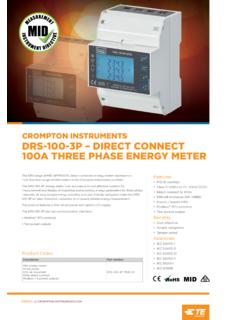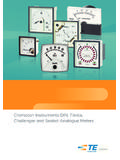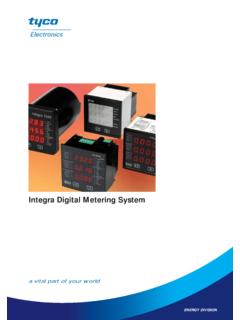Transcription of INSTALLATION INSTRUCTIONS - Crompton …
1 Protector trip Relays DIN Rail & Wall Mounted 250 Series Paralleling & Reverse Power Page 1 of 2 Ref: IW250 DLQRST Rev 8 Oct 03 INSTALLATION INSTRUCTIONS Products Covered 256-PLL 256-PLD 256-PAS 256-PAQ 256-PAT 256-PAR Introduction Models 256-PLL, 256 PLD Paralleling Protector modules provide manual/automatic switching of generator to busbar. The volt free relay contacts change state when voltage, phase relationship and frequency are within the selected synchronising limits. Models 256-PAS, 256-PAT, 256-PAQ, 256-PAR Reverse Power protectors monitor the current and power factor of generators connected in parallel with another generator or with the mains and give an alarm or control signal should power flow into the generator ( reverse power) exceed a user-adjusted level.
2 Model 256-PAQ and 256-PAR have a push to test button. Warning During normal operation, voltages hazardous to life may be present at some of the terminals of this unit. INSTALLATION and servicing should be performed only by qualified, properly trained personnel' abiding by local regulations. Ensure all supplies are de-energised before attempting connection or other procedures. It is recommended adjustments be made with the supplies de-energised, but if this is not possible, then extreme caution should be exercised. Terminals should not be user accessible after INSTALLATION and external INSTALLATION provisions must be sufficient to prevent hazards under fault conditions.
3 This unit is not intended to function as part of a system providing the sole means of fault protection - good engineering practice dictates that any critical function be protected by at least two independent and diverse means. Never open circuit the secondary winding of an energised current transformer. INSTALLATION The Protector should be installed in a dry position, not in direct sunlight and where the ambient temperature is reasonably stable and will not be outside the range 0-60 degrees Celsius. Mounting will normally be on a vertical surface but other positions will not affect the operation and vibration should be kept to a minimum.
4 The protectors are designed for mounting on a 35mm rail to DIN 46277. Alternatively they may be screw fixed. To mount a protector on a DIN rail, the top edge of the cut-out on the back is hooked over one edge of the rail and the bottom edge carrying the release clip clicked into place. Check that the unit is firmly fixed. Removal or repositioning may be achieved by levering down the release clip and lifting the unit up and off the rail. Electromagnetic Compatibility This unit has been designed to provide protection against EM (electro-magnetic) interference in line with requirements of EU and other regulations.
5 Precautions necessary to provide proper operation of this and adjacent equipment will be INSTALLATION dependent and so the following can only be general guidance:- Avoid routing wiring to this unit alongside cables and products that are, or could be, a source of interference. The auxiliary supply to the unit should not be subject to excessive interference. In some cases, a supply line filter may be required. To protect the product against incorrect operation or permanent damage, surge transients must be controlled. It is good EMC practice to suppress differential surges to 2kV or less at the source.
6 The unit has been designed to automatically recover from typical transients, however in extreme circumstances it may be necessary to temporarily disconnect the auxiliary supply for a period of greater than 5 seconds to restore correct operation. Screened communication and small signal leads are recommended and may be required. These and other connecting leads may require the fitting of RF suppression components, such as ferrite absorbers, line filters etc., if RF fields cause problems. It is good practice to install sensitive electronic instruments that are performing critical functions in EMC enclosures that protect against electrical interference causing a disturbance in function.
7 Fusing and connections 1. This unit must be fitted with external fuses in voltage and auxiliary supply lines. 2. Voltage input lines must be fused with a quick blow fuse 1A maximum. 3. Auxiliary supply lines must be fused with a slow blow fuse rated 1A maximum. 4. Choose fuses of a type and with a breaking capacity appropriate to the supply and in accordance with local regulations. 5. Where fitted, CT secondaries must be grounded in accordance with local regulations. Screw torque Main terminal screws should be tightened to or ft/lbf only. Detachable terminal connector screws should be tightened to or ft/lbf only.
8 Where fitted, terminal covers are held in place by miniature self tapping screws into plastic. These screws should be tightened by hand only, sufficiently to secure the terminal cover and prevent it vibrating. Setting Up Model 256-PLL The module is connected to monitor voltage values from both busbar and incoming generator systems. The generator supply powers the electronics and the relay. The input signals are compared for voltage level and phase relationship and when the resultant is below the selected limit a command signal energises the relay. A time delay ensures frequencies are virtually equal at synchronising.
9 Model 256-PLD This operates in the same way as the type 256-PLL, with the addition of the "Dead Bus" facility. This extra feature enables the relay to energise with a generator supply only. Thus the 256-PLD will allow the generator to power the busbar during mains failure. Models 256-PLL and 256-PLD The front mounted, calibrated control should be set to suit operational requirements. A red LED on the front indicates, when lit, that the output relay is in the energised state. Models 256-PAS, 256-PAT, 256-PAQ & 256-PAR All reverse power units have front mounted, calibrated controls and these should be set to suit operational requirements.
10 A red LED on the front indicates, when lit, that the output relay is in the energised state. The output relay is normally arranged to energise on trip . Note, this means that it is necessary to know whether the output relay is arranged to energise or de-energise on trip before the tripped or untripped state of a Protector can be determined from the condition of the LED. The working range is power factors between inductive / Unity / Capacitive Tyco Electronics UK Limited Crompton instruments Freebournes Road, Witham, Essex, CM8 3AH, UK Phone: +44 1376 509 509 Fax: +44 1376 509 511 The Information contained in these INSTALLATION INSTRUCTIONS is for use only by installers trained to make electrical power installations and is intended to describe the correct method of INSTALLATION for this product.









